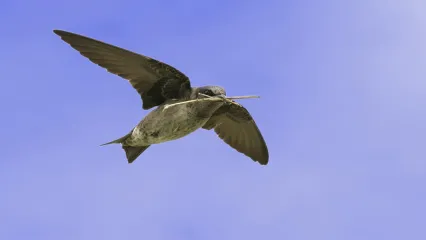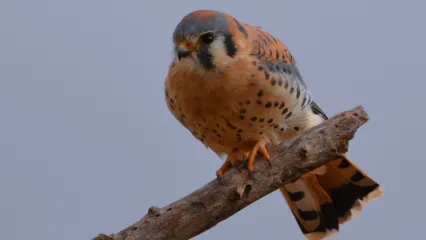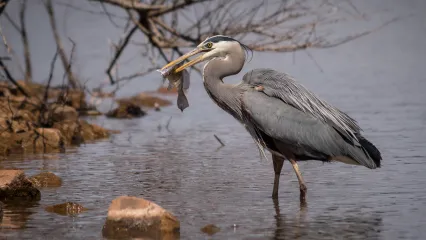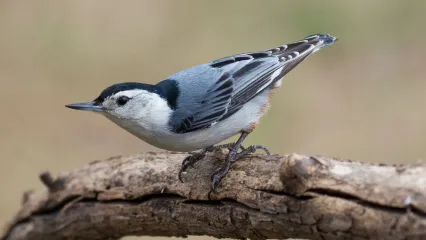
Description
The purple martin is the largest North American member of the swallow family. Other Oklahoma members include the cliff, tree, bank, rough-winged and barn swallows. Purple martins nest in colonies and often locate near human habitation. First-year males and all females are bluish gray with light gray throats and breasts. First-year males will have one or more dark feathers on the throat, chin, breast, flanks, belly or undertail coverts.
Size
Approximately 7.5 to 8.5 inches in length.
Habitat
Purple martins nest in colonies and often locate near human habitation.
Life Cycle
Martins are in the group of birds known as Neotropical migrants; they nest in Oklahoma in the summer and spend winters in Central and South America. Adults arrive in Oklahoma mid-February through May with previous year’s young arriving four to six weeks later. Colonial nesters, both sexes help in the construction of nests made of mud, grasses, leaves, twigs, straw and pine needles. Females incubate 4 to 5 white eggs. Males help insulate these eggs while the female is away. Hatching occurs after 15-16 days. The chicks are able to leave the nest about 28 days after hatching. Martins usually abandon their nest a few days after the young fledge and begin gathering at communal nesting sites prior to migration in late August or early September. These swallows primarily eat insects caught in the air like wasps, grasshoppers, butterflies, and dragonflies. They do not eat a significant number of bees or mosquitoes as widely believed. Most mosquito species are not active during the day when martins are feeding.
How To Observe
Three key factors should be considered when attempting to attract purple martins. These are house location, design and nest management.
- Location: The house should be placed within 100 feet of human activity (house, barn or garden) and must be at least 40 feet from buildings, trees and other obstructions. Martins need a place to perch that provides the best view of open space where insects may be flying. Open areas near water are especially attractive to martins. House height may range from 8 to 30 feet, but 12 to 14 feet is recommended.It sometimes takes several years to attract martins to a new site. If the house is not used in the spring, leave it up until after fall migration. Young birds may discover it as they head south. Then lower and/or plug boxes after fall migration to prevent usage by sparrows and starlings. If nest boxes must be changed, do it over a two year period. Do not eliminate the old nest boxes until some of the martins have accepted the new ones.
- House designs: Native Americans attracted purple martins to their villages by hanging gourds, a housing technique still used today. Gourds may last up to 30 years if properly maintained. They should be soaked for 15 minutes in copper sulfate solution (one pound copper sulfate dissolved in five gallons of water). After they are dried, gourds should be painted with white oil-based paint to minimize heat. The entrance hole should be 2 ¼ inches in diameter, and three to six quarter inch drainage holes should be drilled into the bottom. Nest boxes should be constructed of a lightweight material. For this reason, aluminum structures are considered by many to be ideal as they are lightweight and reflective. Although martins don’t seem to mind the bright interior, the compartments will likely need to be fitted with a special hole-shape to keep starlings out. Each compartment should be about 6X6X6 inches in size and have 2 ¼ inch entry holes. Aluminum apartments are very durable and will remain attractive for years without extensive maintenance. Houses made from PVC pipe material and Masonite are also available. PVC structures are inexpensive to construct and very durable but can be difficult to clean. Wood houses should be ½ to ¾ inches thick to insulate against the heat and cold. Ventilation is essential; some designs have ventilation shafts through the structures center while others are ventilated by small holes drilled in the compartments. Mounting posts can be made of wood or steel.
- Nest box management: Several boxes may be set up in the same yard. When “fully” occupied, a house will have a percentage of compartments vacant. The occupancy rate can be increased by using porch dividers between “apartments.” Martin houses should maintain a relatively cool temperature. Predator guards should be used to protect martins from predators. A section of 4-inch PVC pipe placed around the base of the mounting pole may deter snakes. Another type of predator guard is a cone of smooth metal plastic that umbrellas downward away from the pole. Guards should be at least 40 inches wide to protect martins from predators. When possible, nests should be checked weekly to note any problems with parasites or losses from predators and to remove sparrow and starling nests. Keeping records will help in managing the colony. The most serious problem for purple martins in many areas is nest competition. European starlings and house sparrows have caused large declines in the populations of many native cavity-nesting birds. Starlings and house sparrows are not protected by law and can be controlled by traps, shooting and regular removal of their nests. Parasites such as mites may pose a problem, especially for young birds. Remove infested nest materials if parasites become a problem, replacing it with clean, dry straw or cedar shavings. Old nesting material should be removed at the end of the nesting season.


